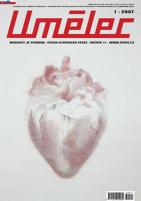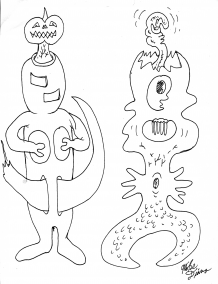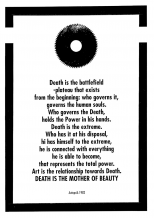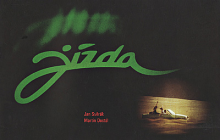|
Jonathan Meese is currently Germany’s most controversial artist. His exhibition Mama Johnny, held in the Deichtorhallen gallery in Hamburg, was the exhibition event of the year. An artist of just 36 years of age, he was given the chance to fill more than a hundred square meters of space. He sold piles of junk to the interested public, labelling them as part of a new, intellectual world system: worn-out and demolished display mannequins, pictures ripped from newspapers, and canvasses messed up with grammatically and orthographically incorrect texts. He splattered the names of a few heroes of the German (more conservative) intelligentsia, like Richard Wagner or Friedrich Nietzsche, but also countless fantasy words, over his pointlessly arranged pictures and collages. It sounds meaningful, but often it can mean nothing or everything – it’s up to the visitors to make up their minds about what nonsense they want to make of it. With his greasy hair, unkempt beard, faded Adidas-gear and, most importantly, with his piercing gaze, Meese has turned himself into a cult figure. In interviews, he claims that this gigantomanic installation, like his art in general, is all based on a meticulously thought-out system of at least ten points (how original: a number pregnant with meaning but also arbitrarily expandable). Sadly, he can’t explain the system because people aren’t ready for it yet. The time has come to ask why the German state and collectors should spend so much money on providing such a confused young drug-addict with a forum to exhibit spewed out paintings and installations so unlovingly patched together. Why should one even invest five minutes of one’s precious time to explore a “system” that even its inventor is unable, or doesn’t want to explain, and that therefore remains nebulous and obsolete? On the art scene, however, Jonathan Meese has filled a long-standing gap. Since Anselm Kiefer has largely withdrawn from the art business, the scene has been in need of another wild German who shocks his audience with pithy words and by consciously breaking taboos; for the play with national-socialist elements is part of both Meese’s and Kiefer’s strategy to attract attention. Yet even more important is the widespread longing for someone to act like a big shot and present intellectually demanding art and an explanation of the world at the same time. As long as all of this takes place in museums, nobody seems too bothered by the fact that, in so doing, they have regressed to the level of pubescent games. Two more examples of artists who enjoy “pissing off” curators and collectors are Carl Andre and Hanne Darboven. They have both developed mathematical systems behind their art – systems that they either don’t talk about, or which they explain in bizarre treatises that would cause any professor of mathematics to shake their head. While their systems are called mathematical, they are completely made up and so arbitrary and interchangeable that they mock all mathematical rules. With Andre and Darboven’s work, everyone seems to be so impressed by the word “mathematics” that no one questions it anymore. Monotonous, rather boring artistic concepts are thus imbued with intellectual value. Meese, Kiefer and Thomas Hirschhorn, among others, do not rely on the aesthetic impact of their art; they feel obliged to enhance it by means of arbitrarily constructed concepts. This, however, is not the actual scandal. The scandal is how gullibly and uncritically the art media and curators adopt these concepts. For the critical question alone reveals the philistine on the scene. Therefore, we continue to chase after artists like Meese, trying to recognise our new Messiah in him, and believe everything he scribbles down on canvas - even if we don’t understand it. Belief does not mean knowledge. It implies a hope for redemption. And no one currently promises us that redemptive moment as successfully as Meese.

Recommended articles

|
|
We’re constantly hearing that someone would like to do some joint project, organize something together, some event, but… damn, how to put it... we really like what you’re doing but it might piss someone off back home. Sure, it’s true that every now and then someone gets kicked out of this institution or that institute for organizing something with Divus, but weren’t they actually terribly self…
|

|
|
There is nothing that has not already been done in culture, squeezed or pulled inside out, blown to dust. Classical culture today is made by scum. Those working in the fine arts who make paintings are called artists. Otherwise in the backwaters and marshlands the rest of the artists are lost in search of new and ever surprising methods. They must be earthbound, casual, political, managerial,…
|

|
|
The editors of Umělec have decided to come up with a list of ten artists who, in our opinion, were of crucial importance for the Czech art scene in the 1990s. After long debate and the setting of criteria, we arrived at a list of names we consider significant for the local context, for the presentation of Czech art outside the country and especially for the future of art. Our criteria did not…
|

|
|
Author dreaming of a future without censorship we have never got rid of.
It seems, that people don‘t care while it grows stronger again.
|
|
































 We Are Rising National Gallery For You! Go to Kyjov by Krásná Lípa no.37.
We Are Rising National Gallery For You! Go to Kyjov by Krásná Lípa no.37.
Comments
There are currently no comments.Add new comment